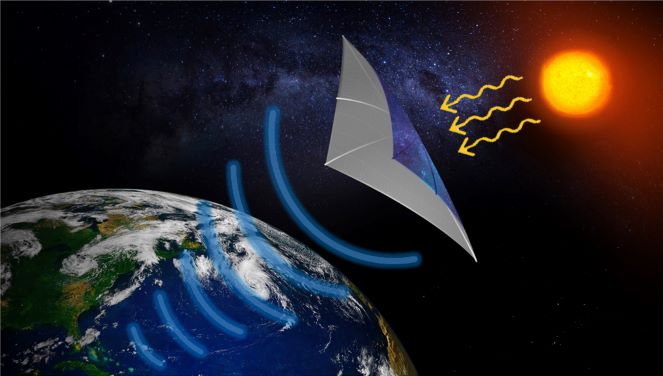Space-based solar power getting key test aboard US military's mysterious X-37B space plane
And some preliminary results are already in.

A U.S. military space plane is being used to flight-validate the best ways to gather the sun's energy for power beaming from Earth orbit.
In mid-March, the latest classified mission of the U.S. Space Force's X-37B robotic space plane winged past 300 days in Earth orbit.
Most of the robotic space drone's duties on this mission, known as Orbital Test Vehicle-6 (OTV-6), are a tightly held secret. However, one known bit of research that the craft carries is the Photovoltaic Radio-frequency Antenna Module Flight Experiment, or PRAM-FX.
The US Military's secretive X-37B space plane: 6 surprising facts
PRAM-FX is a Naval Research Laboratory (NRL) experiment that's investigating transforming solar power into radio frequency (RF) microwave energy. PRAM-FX is a 12-inch (30.5 centimeters) square tile that collects solar energy and converts it to RF power.
Paul Jaffe, the innovation power beaming and space solar portfolio lead at NRL, said that PRAM-FX is not beaming microwave energy anywhere. Rather, the experiment is gauging the performance of sunlight-to-microwave conversion. To be measured is how the PRAM is performing from an efficiency standpoint and also from a thermal performance stance, he said.
Preliminary results
That in-space task is relatively simple. But PRAM-FX helps advance a more ambitious objective — soaking up the sun's energy and broadcasting that power to an energy-hungry Earth.
Breaking space news, the latest updates on rocket launches, skywatching events and more!
The first preliminary results from PRAM-FX aboard OTV-6 were published in January as part of a review paper co-authored by Jaffe in the Institute of Electrical and Electronics Engineers (IEEE) Journal of Microwaves.
"Though these results are preliminary, they compare favorably with the performance documented in ground testing, which also demonstrated 8% total module efficiency. As the experiment proceeds, a full picture of the module's performance under different illumination and temperature conditions in the space environment will be uncovered," the IEEE paper points out.
PRAM-FX is a key orbital test for space solar architectures. But what's next?
Related: How the secretive X-37B space plane works (infographic)
Step-by-step phases
The Air Force Research Laboratory (AFRL) has blueprinted a major demonstration project that aims to beam power collected in space to expeditionary forces on Earth. That project is called the Space Solar Power Incremental Demonstrations and Research (SSPIDR).
As outlined in the IEEE paper, SSPIDR's demonstrations include experiments called Arachne, SPINDLE, and SPIRRAL.
"Arachne will be the world’s first space-to-ground power beaming demonstration of a solar-to-RF modular panel with in-situ surface-shape measurement to optimize beam formation. The solar-to-RF panel technology is designed to scale to very large apertures and to support high volume, low-cost manufacturing," the paper reads.
Arache is scheduled to fly in 2024. AFRL received the first flight hardware component of the Arachne spacecraft from Northrop Grumman last December.
SPINDLE will test on-orbit deployment of a sub-scale version of the operational system. And SPIRRAL "will test thermal management approaches to ensure a long-lasting, high-performance system," the paper reads.
If all goes according to plan, SPIRRAL will launch in 2023 as part of the Materials International Space Station Experiment (MISS-E) Flight Facility. MISS-E is an in-orbit platform from Alpha Space Test and Research Alliance that's designed to be deployed externally on the International Space Station.
Limitless and sustainable energy
John Mankins is a longtime advocate of space power beaming and author of "The Case for Space Solar Power" (Virginia Edition Publishing, 2014). He worked at NASA for 25 years and is now president of Artemis Innovation Management Solutions, LLC.
Space solar power has the potential to transform humankind's future in space, and it might provide a new source of virtually limitless and sustainable energy to markets across the world. So, Mankins said, why wouldn't we pursue such technology?
"There is an array of new players in wireless power transmission — both via radio frequency and laser — in the U.S. and internationally," Mankins told Space.com. "China has just approved the formation of a national-level committee on space solar power and wireless power transmission, which will increase the prominence of their already strong research and development program."
Mankins also points to the United Kingdom. That nation is now exploring the possibility of joining the international space solar power and wireless power transmission community, with a major assessment completed in January of this year.
Looking outward beyond Earth, new applications of wireless power transmission are emerging in lunar exploration planning, Mankins said, where the ice deposits are located exclusively in permanent shadowed regions at temperatures around minus 390 degrees Fahrenheit (minus 234 degrees Celsius).
"But hundreds of kilowatts of power will be needed to mine and process the water ice to make useful materials, such as propellants. Wireless power might be the answer to providing that power," Mankins suggested.
Highly valued asset
Overall, the prospects look encouraging that space power beaming may be a highly valued asset in the commercial sector.
The technology may have a future akin to that of the United States' Global Positioning System, which started out as a military asset and transitioned to a globally utilized technology, experts say. Perhaps solar power beaming will become widely used down the road, providing plentiful solar energy everywhere regardless of the local weather, time of day or latitude.
By the way, for you techno-history buffs: Nikola Tesla originated the concept of large-scale power transfer via free space at the turn of the 20th century!
Leonard David is author of "Moon Rush: The New Space Race," which was published by National Geographic in May 2019. A longtime writer for Space.com, David has been reporting on the space industry for more than five decades. Follow us on Twitter @Spacedotcom and on Facebook. This version of the story published on Space.com.

Leonard David is an award-winning space journalist who has been reporting on space activities for more than 50 years. Currently writing as Space.com's Space Insider Columnist among his other projects, Leonard has authored numerous books on space exploration, Mars missions and more, with his latest being "Moon Rush: The New Space Race" published in 2019 by National Geographic. He also wrote "Mars: Our Future on the Red Planet" released in 2016 by National Geographic. Leonard has served as a correspondent for SpaceNews, Scientific American and Aerospace America for the AIAA. He has received many awards, including the first Ordway Award for Sustained Excellence in Spaceflight History in 2015 at the AAS Wernher von Braun Memorial Symposium. You can find out Leonard's latest project at his website and on Twitter.


